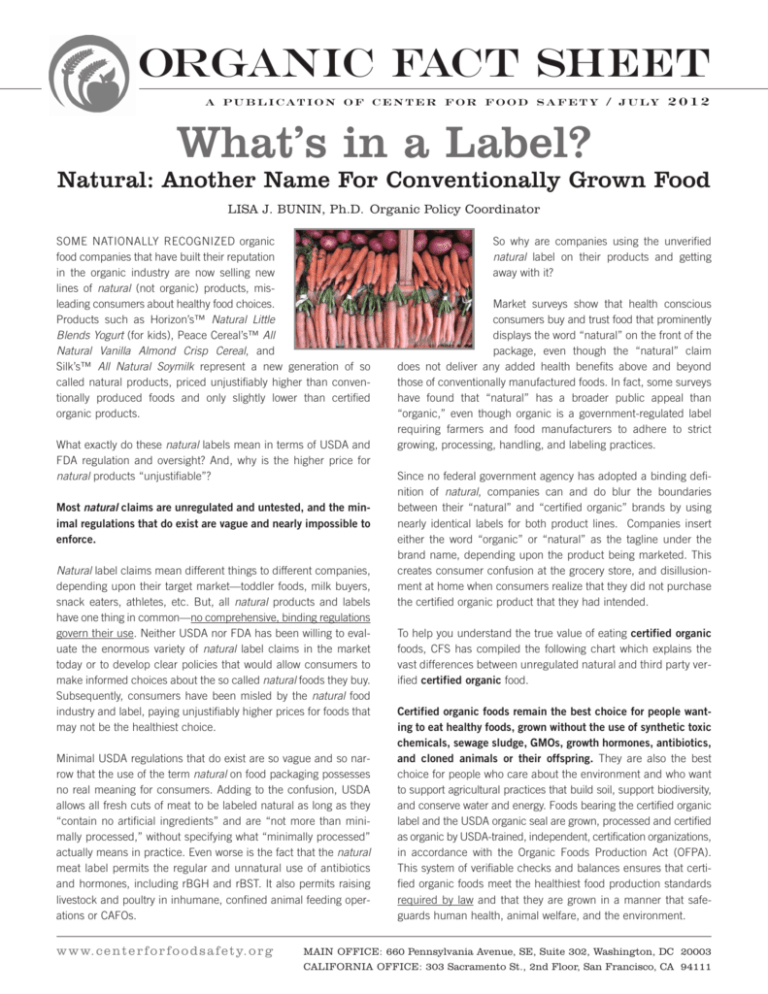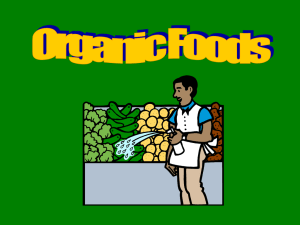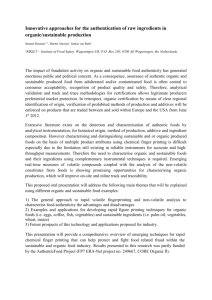View the PDF - Center for Food Safety
advertisement

Organic Fact Sheet a publication of center for food safety / july 2012 What’s in a Label? Natural: Another Name For Conventionally Grown Food LISA J. BUNIN, Ph.D. Organic Policy Coordinator SOME NATIONALLY RECOGNIZED organic food companies that have built their reputation in the organic industry are now selling new lines of natural (not organic) products, misleading consumers about healthy food choices. Products such as Horizon’s™ Natural Little Blends Yogurt (for kids), Peace Cereal’s™ All Natural Vanilla Almond Crisp Cereal, and Silk’s™ All Natural Soymilk represent a new generation of so called natural products, priced unjustifiably higher than conventionally produced foods and only slightly lower than certified organic products. What exactly do these natural labels mean in terms of USDA and FDA regulation and oversight? And, why is the higher price for natural products “unjustifiable”? Most natural claims are unregulated and untested, and the minimal regulations that do exist are vague and nearly impossible to enforce. Natural label claims mean different things to different companies, depending upon their target market—toddler foods, milk buyers, snack eaters, athletes, etc. But, all natural products and labels have one thing in common—no comprehensive, binding regulations govern their use. Neither USDA nor FDA has been willing to evaluate the enormous variety of natural label claims in the market today or to develop clear policies that would allow consumers to make informed choices about the so called natural foods they buy. Subsequently, consumers have been misled by the natural food industry and label, paying unjustifiably higher prices for foods that may not be the healthiest choice. Minimal USDA regulations that do exist are so vague and so narrow that the use of the term natural on food packaging possesses no real meaning for consumers. Adding to the confusion, USDA allows all fresh cuts of meat to be labeled natural as long as they “contain no artificial ingredients” and are “not more than minimally processed,” without specifying what “minimally processed” actually means in practice. Even worse is the fact that the natural meat label permits the regular and unnatural use of antibiotics and hormones, including rBGH and rBST. It also permits raising livestock and poultry in inhumane, confined animal feeding operations or CAFOs. w w w. c e n t e r f o r f o o d s a f e t y. o r g So why are companies using the unverified natural label on their products and getting away with it? Market surveys show that health conscious consumers buy and trust food that prominently displays the word “natural” on the front of the package, even though the “natural” claim does not deliver any added health benefits above and beyond those of conventionally manufactured foods. In fact, some surveys have found that “natural” has a broader public appeal than “organic,” even though organic is a government-regulated label requiring farmers and food manufacturers to adhere to strict growing, processing, handling, and labeling practices. Since no federal government agency has adopted a binding definition of natural, companies can and do blur the boundaries between their “natural” and “certified organic” brands by using nearly identical labels for both product lines. Companies insert either the word “organic” or “natural” as the tagline under the brand name, depending upon the product being marketed. This creates consumer confusion at the grocery store, and disillusionment at home when consumers realize that they did not purchase the certified organic product that they had intended. To help you understand the true value of eating certified organic foods, CFS has compiled the following chart which explains the vast differences between unregulated natural and third party verified certified organic food. Certified organic foods remain the best choice for people wanting to eat healthy foods, grown without the use of synthetic toxic chemicals, sewage sludge, GMOs, growth hormones, antibiotics, and cloned animals or their offspring. They are also the best choice for people who care about the environment and who want to support agricultural practices that build soil, support biodiversity, and conserve water and energy. Foods bearing the certified organic label and the USDA organic seal are grown, processed and certified as organic by USDA-trained, independent, certification organizations, in accordance with the Organic Foods Production Act (OFPA). This system of verifiable checks and balances ensures that certified organic foods meet the healthiest food production standards required by law and that they are grown in a manner that safeguards human health, animal welfare, and the environment. MAIN OFFICE: 660 Pennsylvania Avenue, SE, Suite 302, Washington, DC 20003 CALIFORNIA OFFICE: 303 Sacramento St., 2nd Floor, San Francisco, CA 94111 Issue of Concern Natural Organic Law governing growing, processing & handling No Yes (OFPA) Law regulating label claims No Yes (OFPA) Toxic, synthetic pesticide & fertilizer use Possibly No Sewage sludge applied on farmland Possibly No Genetically Engineered (GE) ingredients Possibly No Animal growth hormones (rBGH & rBST) Possibly No Antibiotic use in livestock and poultry Possibly No Irradiation for food preservation Possibly No Cloned animals & offspring Possibly No Access to pasture required for ruminants No Yes Access to outdoors required for animals No Yes Biodiversity enhancement required No Yes Soil nutrient building required No Yes Crop rotations required No Yes Independent, third-party inspections required No Yes Independent, third-party certification required No Yes Organically grown & processed Possibly Yes Conventionally grown & processed Likely No How Can You Tell It’s Organic?* Look for the Certified Organic Label At the farmers market or farm stand, look for the official certified organic certificate required by law to be prominently posted. At the grocery store, look for an overhead sign or bin that says organic. Individual fruits and vegetables must be individually marked with an organic sticker or imprint. For processed foods, look for the USDA organic seal on the front of the package which guarantees that 95-100 percent of the ingredients in the product is organic. Only 5 percent of the ingredients, at most, can come from the USDA’s list of approved nonorganic ingredients. The name of the certifying agent must be listed on the package. A product labeled made with organic ingredients can contain up to 30 percent non-organic ingredients that are on the USDA’s list of approved non-organic ingredients. Each organic ingredient must be listed on the ingredient label. Made with organic products do not display the USDA organic seal or any certifying agent seal or logo. * NOTE: All non-organic ingredients used in certified organic products and those labeled made with organic ingredients must come from the USDA’s National List of approved substances for use in organic. Such ingredients cannot be produced using excluded methods such as genetic engineering, cloning, nanotechnology, and irradiation, and they cannot harm human health or the environment.





